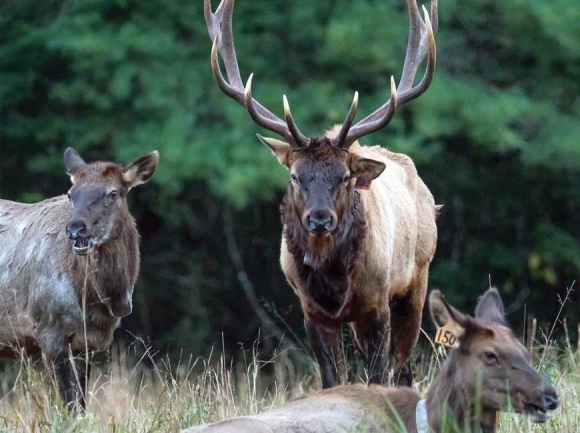2001: Elk return to Western North Carolina
 Adult male elk can weigh up to 1,000 pounds, though 600 to 800 pounds is more common. @bigrromantic photo
Adult male elk can weigh up to 1,000 pounds, though 600 to 800 pounds is more common. @bigrromantic photo
“A large herd gathered last week on a remote, historical farmstead maintained by the Great Smoky Mountains National Park, in Cataloochee Valley,” Don Hendershot wrote for The Smoky Mountain News on Feb. 7, 2001. “The herd, however, were bipeds — nearly 900 people were in attendance for the first of three scheduled elk releases.”
It was a big story for the fledgling newspaper, and a pivotal event for the region as a whole. Elk, various subspecies of which once roamed nearly the entire country, had been absent from North Carolina since the late 1700s — the original populations had disappeared from the rest of their range in the eastern U.S. as well. But after more than 10 years of planning, the first representatives of the species returned to the Great Smoky Mountains National Park.
Starting in 1990, the park began consulting with other agencies about the possibility of reintroducing the huge animals — bulls can weigh up to 1,000 pounds — to the Smokies. By 2000, a study had been completed and returned with a finding of “no significant impact,” clearing the way for elk to be released in Cataloochee Valley.
That brings us to 2001, when 25 elk captured from Land Between The Lakes National Recreation Area in western Kentucky and Tennessee were released Feb. 2 amid what Hendershot described as a “carnival atmosphere” that attracted politicians, park supporters, Cataloochee settler descendents and community members with ages ranging from toddler to senior citizen.
The American elk is the second-largest member of the deer family, and there once used to be six subspecies of it in North America. The Appalachians’ native eastern elk is extinct, so it’s Manitoban elk that now reside in the Smokies, as they’re thought to be most similar subspecies to the extinct natives.
Related Items

When the elk were first released, the project was envisioned more as an experiment in the species’ ability to survive in the Smokies than as an actual reintroduction. The park was planning a five-year intensive study that would include release of about 75 animals over the first three years of the project. Park staff would monitor the population closely to determine the animals’ ability to adapt to their new surroundings and their impact on the park’s ecosystem.
That approach had a significant impact on the mix of animals released back in 2001. While a reintroduction project would release mostly female elk, field researcher Jennifer Murrow told The Smoky Mountain News at the time, the original 25 elk represented a “general mix” of sexes — similar to what you’d see in a natural herd.
The elk made it through their first year with panache. The herd numbered 28 healthy elk by the following January, when the park was revving up to secure a second installation of elk for Cataloochee. These 27 elk would endure a much longer trip — they came from Elk Island National Park, near Edmonton, Canada — and receive a much quieter homecoming, entering the 3-acre acclimation pen in a valley devoid of the crowds of spectators that had awaited the release of the original crew.
It wasn’t a painless adjustment for the elk, which had to learn how to survive in their new environment and keep their young safe from unfamiliar predators like coyotes and bears. But the animals ultimately cleared those hurdles better than wildlife managers had expected — by October 2002 the elk population had grown to nearly 60 animals and the park had decided to forego a third release that had been planned for 2003.
“Overall we are very pleased with the progress of the elk project, including the reproductive success, especially since none of the elk brought in had been exposed to bears or other predators in their former homes,” Kim DeLozier, the park’s wildlife biologist at the time, said in an Oct. 12, 2002, SMN story. “And we would expect that, as they have more experience with predators, these cows will get more savvy about how to conceal and protect their calves in years to come.”
That prediction seems to have proven true. It’s hard to say exactly how many elk now reside in Western North Carolina, as conventional techniques for calculating herd sizes rely on flyover counts made possible by the less tree-covered habitats of the western states, where wild elk populations more commonly occur. But there are at least 150 elk around, and probably more, with herds having formed in Harmon Den and Cherokee in addition to the original group in Cataloochee. Individual roaming elk have been found as far away as Hendersonville, Cashiers and Franklin.
For many, the success of the elk reintroduction is a dream come true. But for others, it’s an inescapable nightmare.
The park’s original reintroduction plan used a zone management philosophy for areas outside the park boundary. Lands directly adjacent to the park would be in the buffer zone, with elk allowed there so long as they caused no significant conflicts. Sensitive areas like agricultural land and populated areas within the buffer zones would be “No Elk Zones” — elk entering these areas would be removed.

Jonathan Creek farmer William Carter shells beans as he discusses the problems elk pose to growers like himself. Holly Kays photo
A problem for some
But ask around, and it’s not hard to find landowners — especially farmers — with less-than-laudatory words about the elk. Like deer, they’re browsers, and they love tasty treats like the uniform rows of crops farmers painstakingly coax from their fields.
“I haven’t had any damage yet, but it’s coming. It’s increasing,” Jonathan Creek farmer William Carter told SMN in 2016, standing in the shade of a large cherry tree as he packed baskets full of that year’s harvest of greasy beans. “I’m seeing more elk, more elk. As of yet I’ve kept them harassed off, and that’s a job in itself. It takes time and effort for me to do.”
It’s not fair, Carter said, that he has to use his scant resources of time and money to deal with the elk issue when it’s an issue the government knowingly created. To a layperson, an elk munching a little grass might not seem like that big a deal, but if you’re a farmer trying to grow enough hay to get your cattle through the winter, it really is.
These tensions have turned violent on more than one occasion, most notably in the case of the Ross family, who keep dairy cows in the Jonathan Creek area. In January 2016, seven elk were shot on the farm for allegedly feeding on winter wheat being grown to feed the cows.
“We’ve worked really hard to try to resolve some of these issues so people can live with elk,” Mike Carraway, the now-retired regional supervisor for the N.C. Wildlife Resources Commission, told SMN in 2016. “The Wildlife Resources Commission is working with landowners to try to resolve some of these issues so we don’t get to the point where people are shooting elk anymore.”
Elk tourism skyrocketing
While the elk have created hardship for some area residents, they’ve opened up opportunity for others, especially those whose livelihoods depend on tourism.
In 2000, the year before the first elk were released, the Cataloochee area of the park saw a total of 65,432 visits. The next year, that figure nearly doubled to 124,844. In 2003 Cataloochee saw its highest visitation ever, with 214,000 visitors. In recent years, Cataloochee’s popularity has moderated somewhat to hang mostly between 90,000 and 100,000, which makes sense — Cataloochee is one of the more difficult park entrances to reach, and with the success of the herd elk can now be seen at the much more easily-accessible Oconaluftee Visitor Center.
But that hasn’t stopped Haywood County from working to capitalize on its status as the elk’s first home in North Carolina. The county’s Tourism Development Authority prominently features a bugling elk on its logo, and this September it will hold the first-ever Smoky Mountain Elk Fest in Maggie Valley. Legislation currently in the General Assembly seeks to christen Haywood County Elk Capital of North Carolina — it’s awaiting a vote from the Senate after the House gave a unanimous yea.
“To see my first elk, I drove 2,200 miles,” Joyce Cooper, co-chair of the Great Smoky Mountains Chapter of the Rocky Mountain Elk Foundation told SMN for a story published Feb. 13 of this year. “Now I can drive 5 miles and see an elk. I’ve had elk on my property. They’ve been grazing on my hayfield, which I never dreamed would happen in my lifetime.”









